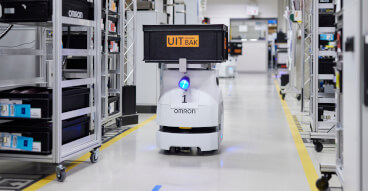As we face the challenge of limited energy resources, it is crucial to prioritize efficiency and maximize value. Our goal is to create resilient manufacturing sites that achieve both a decarbonized society through reduced energy consumption and sustainable business growth through improved productivity. We believe in sharing our knowledge and expertise on energy productivity to empower our customers in the manufacturing industry to join us in our pursuit of sustainable manufacturing. Together, we can pave the way for a brighter, more sustainable future.
Practical Examples of Improving Energy Productivity
1. OMRON Ayabe Factory
Energy productivity was increased by approximately 1.6 times through the continuous centralized monitoring of environmental and production information and through accelerated energy control.
At OMRON's Ayabe Factory we have been committed to protecting the environment for over a decade. Through continuous centralized monitoring of both environmental and production data and the implementation of advanced energy control techniques, we have successfully increased our energy productivity by 1.6 times. By carefully monitoring power consumption and production information, we were able to identify areas for potential energy reduction and implement effective control measures. As a result, power consumption in the cleanroom decreased by 40%, and we optimized the control of other energy-consuming equipment, leading to a 35% increase in factory shipments and a 15% reduction in power consumption on production lines.
2. CLECA
Realization of an 8% increase in productivity using the existing equipment
In response to the rapidly increasing market demands in the food industry, we addressed the urgent issue of production capacity expansion by realizing improved productivity using the existing equipment.
Learn more3. ULVAC
Realization of a 23% reduction in energy consumption on factory equipment
We gained an understanding of the times when vacuum pump operation could be stopped and realized a reduction in power consumption through idling control to only supply electric power when necessary and in the amount necessary.”
Download customer story
4. Okayama Murata Manufacturing
Aiming for decarbonization and energy optimization through inter-company joint development with customers.
We began efforts for joint development with the customer to improve energy efficiency, such as by visualizing the environmental information in the cleanroom.
Solutions to improve energy efficiency
Realizing the visualization of energy information and optimal power control by using technology and knowledge accumulated over more than ten years
i-BELT Data Services
This is a service for joint development with customers to utilize the manufacturing expertise of the customer and the unique know-how, technology, and products of OMRON to realize the ideal state of a factory.
Read moreEnergy control currently being developed and verified at our factory
We are developing energy control methods at our own factory such as cleanliness prediction control, idling control, compressor control, and air conditioning/ventilation control, for four elements that constitute the electric power. We are conducting verification in preparation for the extension of the technologies and knowledge to our customers.
Interesting to Read

Powering through the energy and fuel crisis with automation
07. joulukuuta 2022 To counter rising prices and meet environmental targets, industrial enterprises should explore how automation technologies from a single source might help contribute to their sustainability strategy.High energy and fuel prices are putting a strain on both households and industry. Not only is the situation negatively impacting financial plans and wallets, but the excessive prices are forcing some companies to cease production. According to Make UK 42% of manufacturers surveyed said that their electricity bills have increased by 100% in the past 12 months and 32% said that gas prices have increased by over 100% in the past year. A worrying 12% of manufacturers have already made job cuts as a direct result of increased energy bills.The war in Ukraine, Covid-19 pandemic, and gas pricing are only a few of the causes of the crisis, which impacts all sectors and has an impact on everything from power prices to supply chains. What should manufacturing companies consider now? Comprehensive automation strategies are essential for greater flexibility and energy efficiency. This includes innovative robotics paired with sensor and vision technology as well as artificial intelligence – AI at the Edge. In addition, real-time data from production plants can assist with detecting anomalies and improving overall equipment effectiveness (OEE).

Goal Carbon Zero: OMRON Commits to Doubling Energy Productivity by 2040
OMRON has become a member of The Climate Group's "EP100" initiatives. OMRON is the first Japanese company in the manufacturing industry and the fourth Japanese company in general to join the EP100 initiative, which brings together over 120 energy smart businesses committed to measuring and reporting on energy efficiency improvements.
